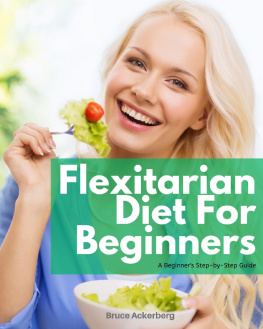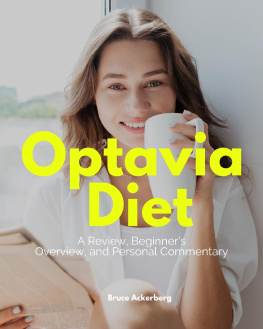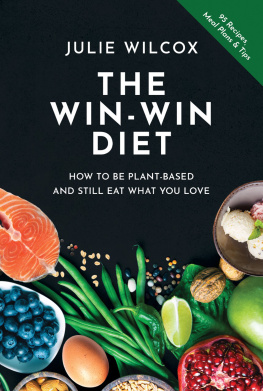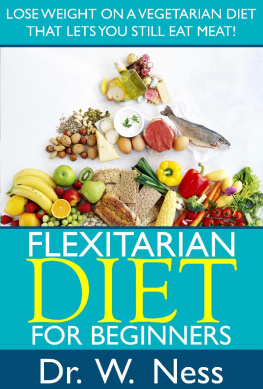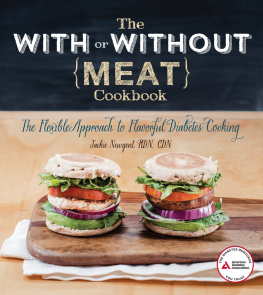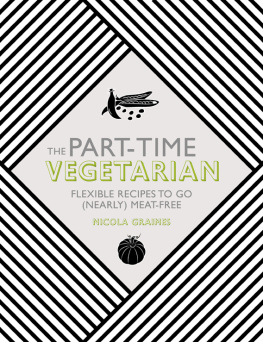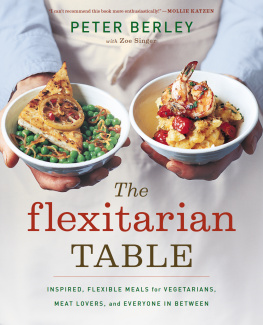Flexitarian Diet
A Beginners Step-by-Step Guide With Recipes
Copyright 2019 Bruce Ackerberg
All rights reserved. No portion of this book may be reproduced in any form without permission from the publisher, except as permitted by U.S. copyright law.
Disclaimer
By reading this disclaimer, you are accepting the terms of the disclaimer in full. If you disagree with this disclaimer, please do not read the book. The content in this book is provided for informational and educational purposes only.
None of the information in this book should be accepted as independent medical or other professional advice.
The information in the books has been compiled from various sources that are deemed reliable. It has been analyzed and summarized to the best of the Author's ability, knowledge, and belief. However, the Author cannot guarantee the accuracy and thus should not be held liable for any errors.
You acknowledge and agree that the Author of this book will not be held liable for any damages, costs, expenses, resulting from the application of the information in this book, whether directly or indirectly. You acknowledge and agree that you assume all risk and responsibility for any action you undertake in response to the information in this book.
You acknowledge and agree that by continuing to read this book, you will (where applicable, appropriate, or necessary) consult a qualified medical professional on this information. The information in this book is not intended to be any sort of medical advice and should not be used in lieu of any medical advice by a licensed and qualified medical professional. Always seek the advice of your physician or another qualified health provider with any issues or questions you might have regarding any sort of medical condition. Do not ever disregard any qualified professional medical advice or delay seeking that advice because of anything you have read in this book.
Table of Contents
Introduction
I want to thank you for investing in this guide.
In recent years, several new diet ideas have emerged, promising quick and easy meal regimens that can burn fat layers in a few weeks. These include the keto diet and intermittent fasting. But if you look closely, these diets actually require a rather strict eating regimen that can take away the fun out of food.
Food is meant to be enjoyed in all its forms, shapes, sizes, texture and taste. The key to enjoying nutritious and tasty meals without the rigid restrictions of the regular diet plan is flexibility and that is what flexitarian diet is all about.
The term flexitarian comes from the words flexible + vegetarian referring to a method of eating that can minimize meat and fat intake without completely removing meat from your diet. A flexitarian diet is ideal for someone who wants to be more of a vegetarian than a carnivore but cant exactly part from the succulent meat dishes. Being a flexitarian offers immense benefits and advantages that you will appreciate.
You will surely gain a fit and shapely body if you obediently stick to the flexitarian diet rules, which are not difficult to follow at all. You may need to create some adjustments in your lifestyle and habits, and this book will guide you from day one of your transition phase.
In order to guide you properly, this book will teach you:
What flexitarian diet is.
The advocacies behind the flexitarian diet.
The foremost things that you need to do in order to embrace flexitarianism with ease.
The additional food groups that the diet includes.
Two options that you can choose from if you follow a flexitarian diet.
How to do the different recipes that are included and use them to plan your meal.
Other important things about flexitarian diet.
The flexitarian diet is so flexible that you may never feel like following a certain type of diet at all. The delicious and tempting recipes that are included in this book are enticing and appetizing enough for the whole family to enjoy.
You will gain better health and body in a matter of time, and the best part is you can do the same with the whole family. They wont even notice that they are eating a flexitarian meal, unless you explicitly tell them.
Thanks again for downloading this book, I hope you enjoy it!
Chapter 1: What is Flexitarian Diet?
A flexitarian diet consists of plant and animal protein, although it should revolve around plant component more than meat from animals. It offers great flexibility and you wont find it troublesome to follow the diet. In simpler terms, the flexitarian diet allows you to live a vegetarian lifestyle without the need to follow the strictly-plant-food-sources-only rule.
There are flexitarians (people who follow the flexitarian diet) who prefer to have an all-meat diet once a month or on rare occasions, meat-free meal once a week, or meat-free meal for a week. The main idea is that you need to eat more vegetables than meat. Another point that has to be made about flexitarian diet is that it is much more than just about cutting down on meat, and is also about avoiding processed food.
The popularity of flexitarian diet continues to rise. The word flexitarian was first used as early as 2003 and has since then gained its own following. The term was officially added to the Oxford English Dictionary in 2014 as increasingly more and more consumers are starting to abstain from eating pork on a regular basis.
Benefits of being a Flexitarian
First of all, here are a few facts about flexitarians: flexitarians actually weigh less (up to 15 percent less) compared to meat-eaters and are less prone to heart diseases, diabetes, and cancer. Furthermore, people who live on plant-based diets are also expected to live 3.6 years longer compared to others.
People who find it hard to be a vegetarian but still want to get the full advantage of vegetarianism can benefit a lot from following a flexitarian diet. To give you an idea and some incentive to inspire you to begin a flexitarian diet, here are some of its benefits:
Weight loss studies have revealed that people following a high-vegetable intake diet have body mass indexes (BMIs) that fall within the normal range. When you closely follow flexitarian rules, you can benefit from reduced body fat due to calorie counting. In addition, weight loss is further facilitated with a diet that is low in calories and high in fiber something that flexitarian diets are known for.
Increased life expectancy compared to meat-eaters, studies found out that people who eat more fruits, vegetables, nuts and grans have lower risks of contracting cardiovascular diseases and cancer. The flexitarian diet allows for higher intakes of food rich in antioxidants, vitamins, fiber, minerals, and phytochemicals or plant proteins.
Improved metabolism with fibrous fruits and vegetables integral in the flexitarian diet, your metabolism can never go wrong. There is also emerging evidence that semi-vegetarian diets (SVD) can treat bowel diseases such as Crohns disease among other inflammatory bowel disorders.
Lower blood sugar studies are also increasingly pointing out the role that semi-vegetarian diets play in lowering blood glucose levels especially for people living with diabetes. In addition to being an excellent maintenance habit, the flexitarian diet also decreases the risk of acquiring type 2 diabetes.
Overall, flexitarians tend to experience the same benefits that vegetarians and vegans get from higher life expectancies to lower body weights. But the edge you get from a flexitarian diet lies in the occasional meat intake which remains a necessary source of protein for the human body.
How It Works
In many ways, while the flexitarian diet prides itself for not having excessive diet restrictions, it still follows a scientific approach. The flexitarian diet is meant NOT for people to follow strictly, but as a guide for them to enjoy the benefits of a vegetarian lifestyle with occasional meat and fish intake. This is how it works:
Next page
